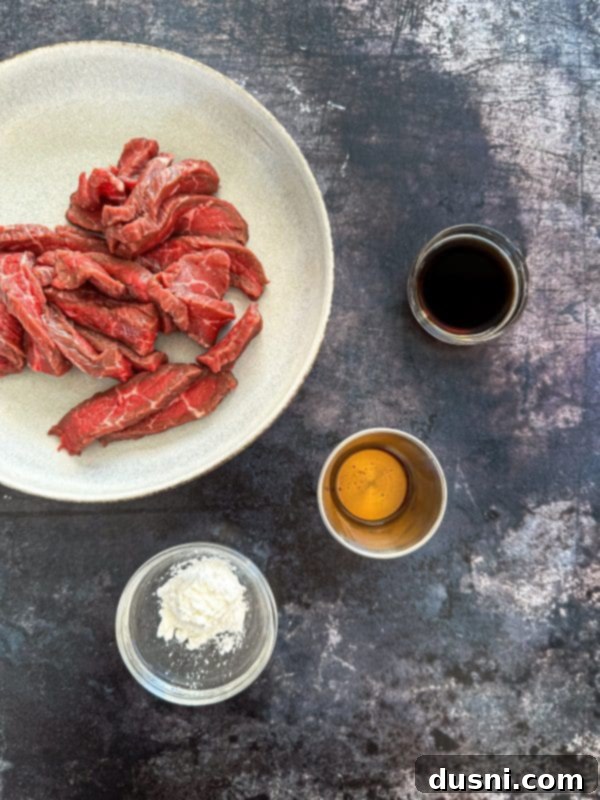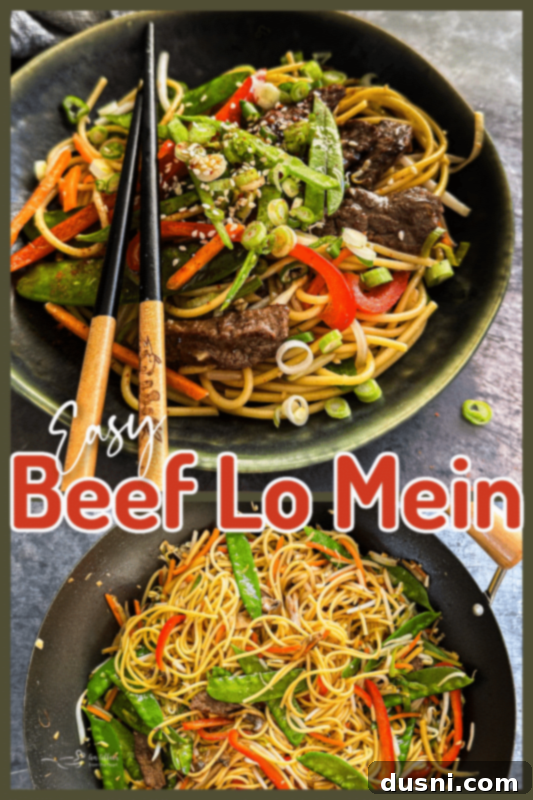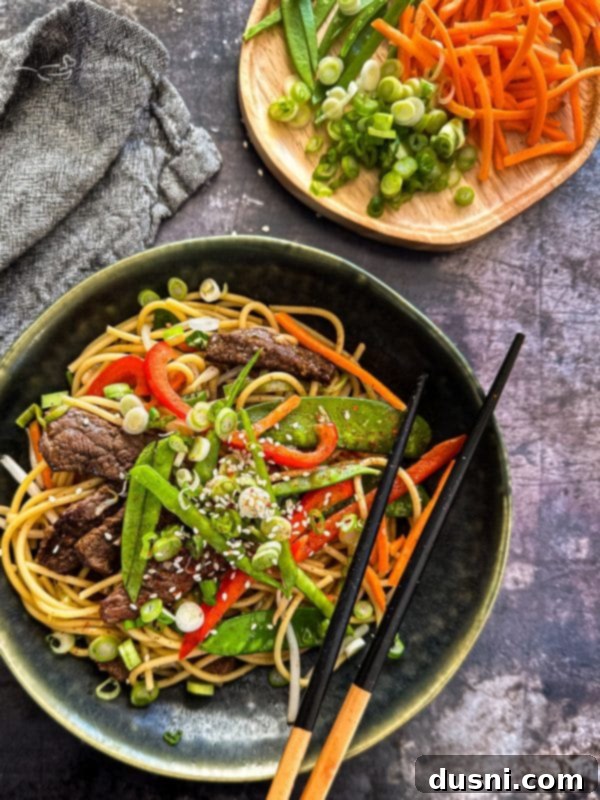Homemade Beef Lo Mein: Your Ultimate Takeout-Style Stir-Fry Recipe
Indulge in the vibrant flavors of Asia right in your own kitchen with this incredible Beef Lo Mein recipe. Featuring thinly sliced, perfectly seared steak, an abundance of crisp, colorful fresh vegetables, and tender noodles all stir-fried in a rich, savory homemade sauce, this dish is a fantastic alternative to your usual Chinese takeout, promising a healthier, fresher, and equally delicious experience.
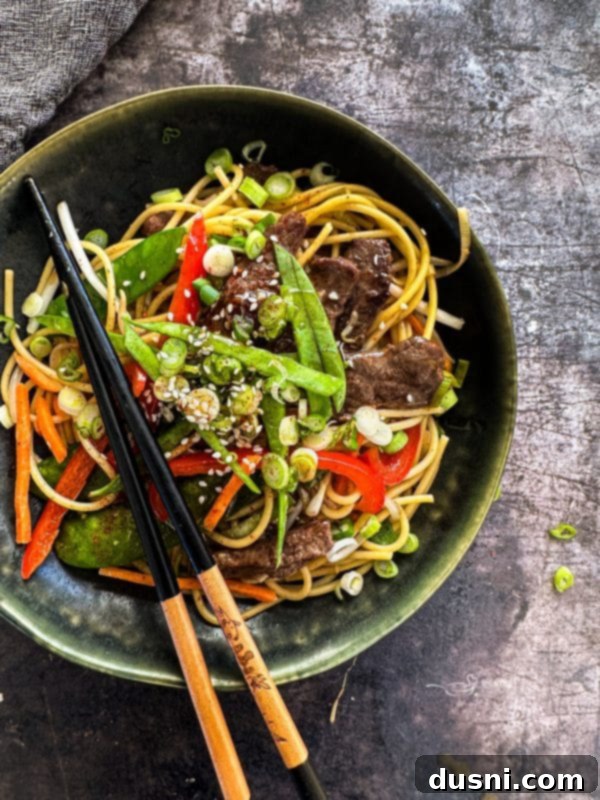
Are you craving the comforting flavors of Chinese cuisine but prefer the freshness and control of a home-cooked meal? Look no further! This Beef Lo Mein recipe is a true “Chinese Take-Out Fake Out” that will satisfy your cravings and quickly become a new family favorite. In our home, when pizza isn’t the unanimous choice, Chinese food often is. While everyone might have their specific go-to dish, a well-made Lo Mein is always a crowd-pleaser.
The inspiration for this recipe struck one day when I had an extra steak and a desire to create something exciting at home. The result was this incredibly flavorful and versatile Beef Lo Mein, which has been a staple in my recipe rotation ever since. It’s not just a meal; it’s an experience that brings the delicious essence of an Asian restaurant into your dining room, minus the wait and the mystery ingredients.
What Makes Our Beef Lo Mein So Special?
Our homemade Beef Lo Mein is bursting with flavor and texture. It features succulent, pan-seared steak strips combined with an abundance of fresh, crunchy vegetables and perfectly cooked noodles, all coated in a harmonious sweet and savory soy-based sauce. This “better than takeout” stir-fry comes together in mere minutes, making it an ideal choice for a busy weeknight when you need a quick, satisfying, and wholesome meal. Serving it hot right from the pan ensures maximum enjoyment of its aromatic flavors.
A Versatile and Easy Beef Lo Mein Recipe
This isn’t just a recipe; it’s a foundation for culinary creativity! Our Beef Lo Mein recipe is incredibly adaptable, making it an excellent way to utilize any leftover vegetables lingering in your fridge at the end of the week. Don’t have time for a grocery run? No problem! Toss in whatever fresh produce you have on hand, or even some frozen mixed vegetables. Feel free to switch out the traditional lo mein noodles for rice noodles, buckwheat noodles, or even serve the stir-fry over a bed of fluffy rice. For a different protein, chicken, pork, or shrimp work wonderfully, and tofu can easily transform it into a delightful vegetarian Lo Mein.
The best part? You won’t need to embark on a special trip to an Asian market for obscure ingredients. This delightful lo mein can be prepared using common items found in most supermarkets, right in the comfort of your own kitchen! If you love Asian-inspired dishes, you might also enjoy these other fantastic recipes: Ginger and Basil Fried Rice, Asian Beef, Mushrooms, and Snow Peas, or this refreshing Asian Slaw.
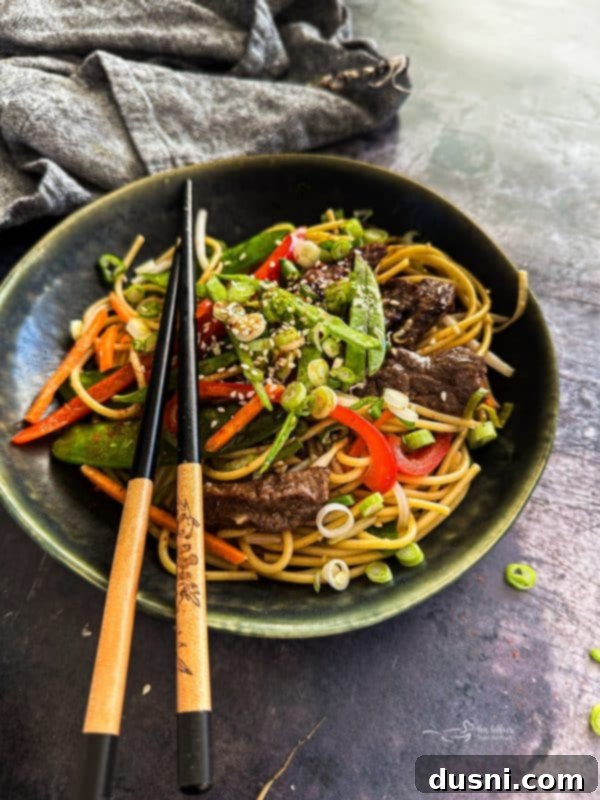
This beef lo mein recipe is healthy, incredibly flavorful, and deceptively easy to prepare. It’s a dish you truly can’t go wrong with. It’s important not to confuse Lo Mein with its cousin, Chow Mein. While both are noodle dishes, traditional Chow Mein often features thinner, sometimes egg-based noodles that are stir-fried until crispy. In contrast, this Lo Mein dish uses long, soft, chewy noodles that are perfect for soaking up every drop of the rich, savory sauce, offering a distinct and equally delicious experience.
Essential Beef Lo Mein Ingredients
For a complete list of ingredients with precise measurements and detailed cooking instructions, please scroll to the bottom of this post for the full printable recipe card. Here’s a breakdown of what you’ll need and why each component is important:
- Sirloin steak: We recommend cutting it into thin strips. Sirloin is tender and cooks quickly, perfect for stir-frying. Other good choices include flank steak or skirt steak.
- Soy sauce: This forms the savory base of our sauce and marinade. Use a low-sodium variety if you’re watching your salt intake, or regular for a richer flavor.
- Corn starch: Crucial for thickening the sauce, giving it that desirable glossy consistency, and also for coating the beef, which helps tenderize it and creates a slight crust when seared.
- Sesame oil: A key ingredient that infuses the entire dish with a distinctive, nutty, and aromatic Asian flavor. A little goes a long way!
- Spaghetti or Linguine: While traditional lo mein noodles are ideal, long-shaped pasta like spaghetti or linguine makes an excellent and readily available substitute, providing that satisfying chewiness.
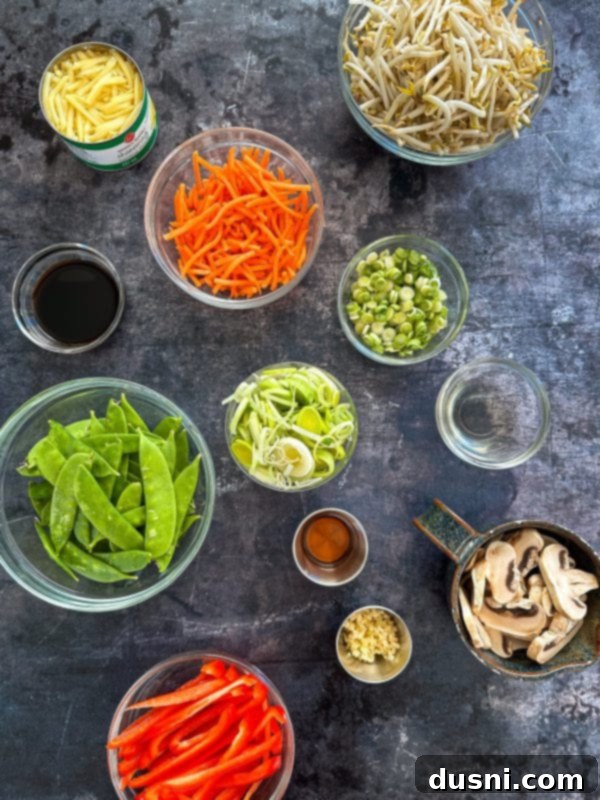
- Mung bean sprouts: Whether fresh or canned, these add a wonderful, crisp texture and a subtle freshness to the stir-fry, typical of authentic lo mein.
- Bamboo shoots: Canned bamboo shoots contribute a unique, slightly crunchy texture and an authentic earthy flavor that enhances the Asian profile of the dish.
- Carrots: Shredded carrots not only add a touch of sweetness but also a beautiful pop of orange color and an extra layer of crunch.
- Leeks: Washed well and sliced, leeks provide a milder, sweeter onion flavor than traditional onions, adding depth without overpowering other ingredients.
- Mushrooms: Fresh button mushrooms or cremini mushrooms, sliced, absorb the sauce beautifully and add an umami richness.
- Red bell pepper: Sliced red bell peppers bring vibrant color, a sweet and slightly tangy flavor, and a satisfying crunch.
- Snow peas: These delicate peas add a fantastic crisp-tender bite and a fresh green element to the lo mein.
- Garlic: Freshly minced garlic is always best for its pungent aroma and robust flavor, but jarred minced garlic can be used in a pinch.
- Rice vinegar: This ingredient adds a crucial touch of acidity and a subtle sweetness, balancing the richness of the soy sauce and enhancing all the flavors.
- Green onions: The green tops (also known as spring onions), sliced for serving, are an optional but highly recommended garnish, adding a fresh, mild onion flavor and visual appeal.
Crafting This Easy Beef Lo Mein: Step-by-Step Guide
You’ll be amazed at how quickly and effortlessly this delicious beef lo mein comes together. The key to a successful stir-fry is having all your ingredients prepped and ready to go before you even turn on the heat. This is often called “mise en place” – everything in its place!
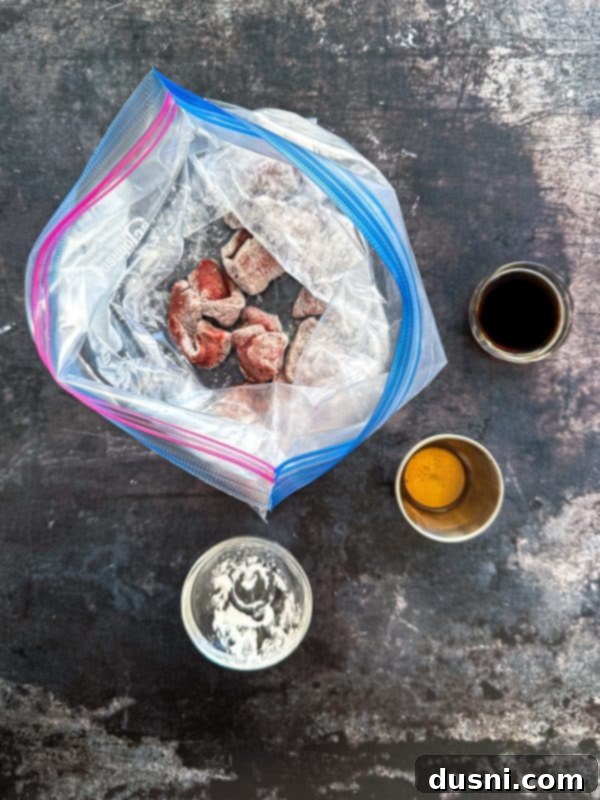
First, prepare your beef. Slice your sirloin steak into thin, uniform strips. This ensures even cooking and tenderness. Place the beef strips into a gallon-sized zip-top bag. Sprinkle the cornstarch over the meat, then toss or shake the bag to ensure the meat is thoroughly coated. This step helps tenderize the beef and will contribute to a silky sauce. Next, add two teaspoons of soy sauce and one teaspoon of sesame oil to the bag with the beef. Seal the bag and squeeze the meat to coat it thoroughly with the marinade. Set aside while you prepare the vegetables.

Now, chop all of your fresh vegetables as instructed in the recipe card, and have them ready and organized. Once you start cooking, the process moves very quickly, so having everything prepped beforehand is crucial for a smooth and successful stir-fry. Slice your leeks, shred your carrots, dice the bell pepper, and mince your garlic.

Cook your chosen noodles according to package directions until al dente. For lo mein, you want them tender but still with a slight bite. Once cooked, rinse the noodles thoroughly in cool water to prevent them from sticking together and to stop the cooking process. Set them aside.
Heat a wok or a large skillet over high heat. Add a couple of teaspoons of sesame oil to the hot pan. Once the oil is shimmering and hot, add the marinated beef. Sear the beef strips quickly on both sides until browned, about 1-2 minutes per side. Overcooking will make the beef tough, so work in batches if necessary to avoid crowding the pan. Use tongs to remove the seared beef from the pan and set it aside.
In the same wok or skillet, add the minced garlic and all the prepared vegetables, *except* for the mung bean sprouts and snow peas. Stir-fry these harder vegetables on high heat for a couple of minutes until they start to become tender-crisp. Then, add the rice wine vinegar, the remaining soy sauce, and the remaining sesame oil. Stir well to combine and coat the vegetables. Now, add the bean sprouts and snow peas to the pan. Continue to stir-fry for another minute or two, just until the snow peas are bright green and tender-crisp.
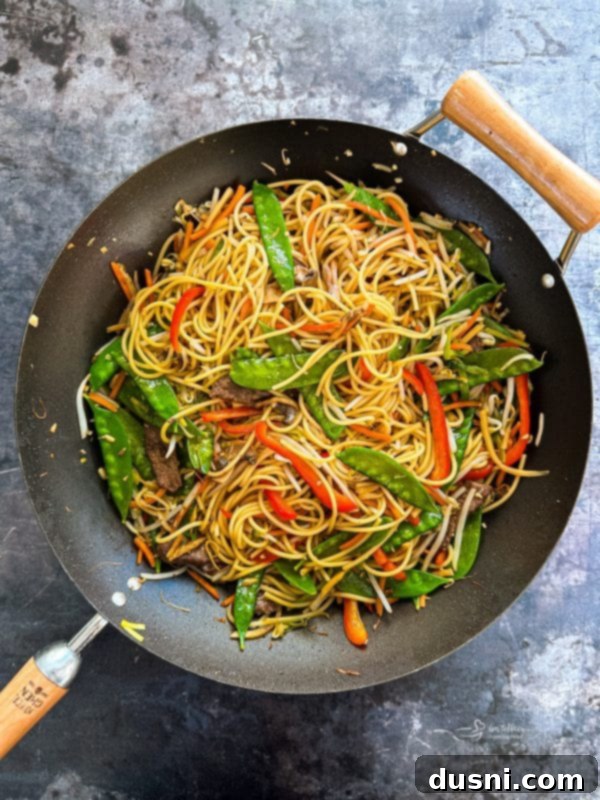
Finally, return the seared beef and the cooked noodles to the wok with the vegetables and sauce. Toss everything together, continuing to stir-fry for a few more minutes until all the ingredients are well combined and most of the liquid from the sauce has been absorbed by the noodles and vegetables, creating that signature glossy coating. The sauce should cling beautifully to every strand and piece.
Serve your delicious homemade Beef Lo Mein hot immediately! Garnish with sliced green onions for an extra burst of freshness and color, if desired. Leftovers can be stored in an airtight container in the fridge for 3-4 days. While you can freeze Beef Lo Mein, be aware that the vegetables may become a bit softer in texture once thawed and reheated. In the freezer, this dish will keep well for up to 3 months.
Love It? Pin It!
If you’re as excited about this fantastic Beef Lo Mein recipe as we are, don’t let it slip away! Make sure to save it for later by pinning it to your favorite Pinterest recipe board before you go. It’s a dish you’ll want to make again and again!
Frequently Asked Questions (FAQs) About Beef Lo Mein
- How do I make beef lo mein at home? Making beef lo mein at home is surprisingly simple! Just follow our detailed recipe instructions above and in the recipe card below. The process involves marinating beef, cooking noodles, quickly stir-frying vegetables, and then combining everything with a savory sauce in a wok or large skillet.
- What exactly is beef lo mein? Beef Lo Mein is a popular Chinese-American dish consisting of tender strips of beef, soft and chewy wheat noodles, and a colorful array of stir-fried vegetables, all coated in a rich, savory, soy-based sauce. It’s known for its comforting texture and robust flavor profile.
- What are the main components of beef lo mein? Our Beef Lo Mein typically features thinly sliced beef (such as sirloin), long wheat noodles (like spaghetti or linguine as a substitute), and a variety of fresh vegetables. Common vegetables include shredded carrots, sliced leeks, mushrooms, red bell peppers, mung bean sprouts, and snow peas, all bound by a flavorful Asian sauce.
- What’s the key difference between beef lo mein and chow mein? The primary distinction lies in the noodles and their preparation. Beef Lo Mein typically uses thicker, soft, and chewy noodles that are tossed with the sauce and other ingredients. Chow Mein, on the other hand, often features thinner, sometimes egg-based noodles that are usually stir-fried until crispy, providing a different textural experience.
- What is the sauce in lo mein typically made of? The signature lo mein sauce is usually a harmonious blend of soy sauce, aromatic garlic, sometimes ginger, and rice wine vinegar for a touch of sweetness and acidity. Depending on the recipe, it might also include sesame oil, a touch of sugar, or other umami-rich ingredients to create a perfectly balanced flavor.
- What are good side dishes to serve with beef lo mein? Beef Lo Mein is a complete meal on its own, but it pairs wonderfully with many other Asian-inspired dishes. Consider serving it alongside crispy egg rolls, a vibrant mixed vegetable salad, or a simple fried rice. For a lighter option, a fresh Asian slaw or steamed bok choy would be excellent companions.
- Is this beef lo mein recipe healthy? When made at home, Beef Lo Mein can be a very healthy and balanced meal. It’s packed with lean protein from the beef and a generous amount of fresh vegetables, providing essential vitamins and fiber. By controlling the amount of oil and choosing low-sodium soy sauce, you can easily make it even healthier than restaurant versions.
Smart Substitutions for Your Lo Mein
One of the best aspects of this Beef Lo Mein recipe is its incredible flexibility. Don’t be afraid to get creative and tailor it to your personal preferences, dietary needs, or whatever ingredients you have on hand. Making it your own is part of the fun!
- Customize the Sauce: While our sauce is delicious, feel free to experiment with different combinations. Try adding a tablespoon of hoisin sauce for sweetness and depth, oyster sauce for extra umami, or a splash of dark soy sauce for a richer color and slightly different flavor profile. A dash of sriracha or red pepper flakes can add a welcome kick.
- Noodle Alternatives: If spaghetti or linguine isn’t what you’re craving, modify the noodles! Traditional fresh or dried egg noodles (often labeled “lo mein noodles”) are fantastic. Rice noodles offer a gluten-free option, while buckwheat noodles (soba) provide a unique nutty flavor. Any long, sturdy noodle will work well.
- Protein Swaps: The beef can easily be swapped for other proteins. Flank steak or skirt steak are excellent beef alternatives. Chicken breast or thighs (sliced thin), shrimp (cook briefly at the end), or thinly sliced pork tenderloin are all delicious choices. For a vegetarian lo mein, cubed firm tofu or tempeh are excellent protein sources that absorb the sauce beautifully.
- Vegetable Variations: The sky’s the limit when it comes to vegetables! Add or substitute with broccoli florets, bok choy, snap peas, sliced zucchini, shredded cabbage, water chestnuts, baby corn, or bell peppers of different colors (yellow, orange). This is a perfect way to use up leftover produce.
- Adjust Sweetness: For a sauce that leans more towards sweet than savory, simply add a tablespoon of brown sugar, honey, or maple syrup. Taste and adjust to your preference.
- Sesame Oil Substitute: If you don’t have sesame oil, you can use a neutral vegetable oil like canola or grapeseed oil for cooking. However, be aware that your stir-fry won’t have the same distinctive nutty aroma and flavor that sesame oil provides, so consider adding a few drops of toasted sesame oil at the end if possible.
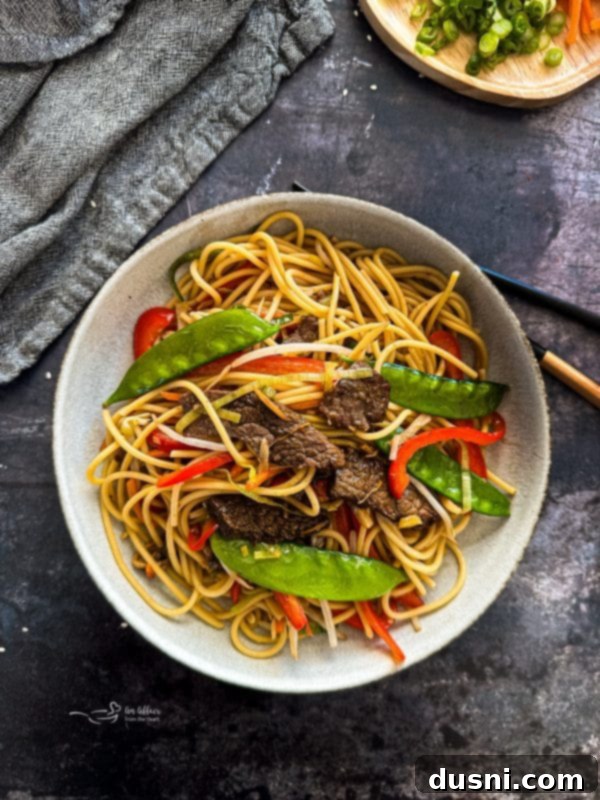
Chef’s Tips & Tricks for Perfect Lo Mein
- Wok vs. Skillet: While a wok is ideal for stir-frying due to its sloped sides and even heat distribution, don’t fret if you don’t have one. A large, heavy-bottomed skillet (like a cast iron skillet) or a non-stick pan will work just as effectively. The key is to use high heat and not overcrowd the pan.
- Speedy Meal Prep: For ultimate weeknight convenience, keep a bag of frozen mixed stir-fry vegetables in your freezer. This allows you to whip up this delicious recipe any day of the week, even when fresh produce is low. Just add them directly to the wok!
- Garnish for Flavor and Crunch: Elevate your easy beef lo mein recipe with a simple garnish. A sprinkle of toasted sesame seeds adds an extra layer of nutty flavor and a delightful textural crunch. Freshly chopped cilantro or additional green onions also brighten the dish.
- High Heat is Key: Stir-frying requires high heat to achieve that perfect crisp-tender texture in vegetables and a good sear on the beef. Make sure your wok or skillet is very hot before adding ingredients.
- Don’t Overcrowd the Pan: Cooking in batches, especially the beef, is crucial. Overcrowding lowers the pan’s temperature, leading to steamed instead of stir-fried ingredients, which can result in a soggy dish.
More Delicious Asian-Inspired Recipes to Love
If you enjoyed this Beef Lo Mein, you’ll surely appreciate these other fantastic recipes from our collection:
-
Sweet and Sour Brussels Sprouts: A unique and flavorful side dish.
-
Teriyaki Chicken Casserole: A comforting and easy weeknight meal.
-
Thai Chicken Noodle Soup: A warming and aromatic bowl of goodness.
- Sweet & Sour Chicken (pictured above): A classic takeout favorite, made easy at home.
-
Fried Rice: The perfect accompaniment to any Asian meal.
-
Ginger Soy Dressing: A versatile dressing for salads or marinades.
See All of My Asian Recipes for more inspiration!
Noodle dishes are consistently popular with the whole family, and this homemade beef lo mein is bound to be no exception. Its rich flavors, satisfying textures, and customizable nature make it a perfect addition to your weekly meal plan. Enjoy!
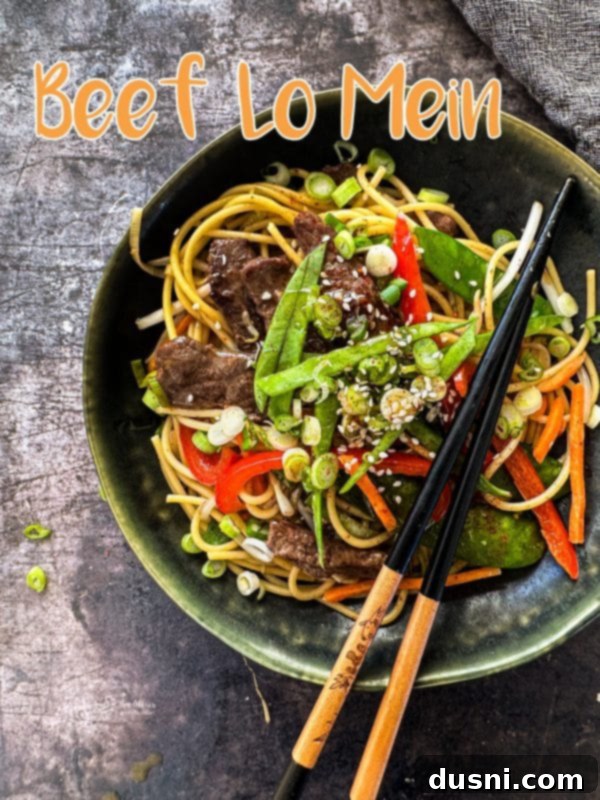

LIKE THIS RECIPE?
Don’t forget to give it a ⭐️⭐️⭐️⭐️⭐️ star rating and
leave a comment below the recipe!

Print Recipe
Beef Lo Mein
Equipment
-
Reusable Chopsticks Japanese Natural Wooden 5 Pairs
-
12-Piece Black Sharp Knife Set with Covers, Cutting Board and Sharpener
-
Carbon Steel Wok, 13 Inch Wok Pan with Lid and Spatula,
Ingredients
- 5 ounces sirloin steak cut into thin strips
- 2 teaspoons soy sauce
- 2 teaspoons corn starch
- 1 teaspoon Sesame oil
- 12 ounce package spaghetti or linguine noodles
- 1 14.5 ounce can Mung bean sprouts
- 1 8 ounce can Bamboo shoots
- 1 cup shredded carrots
- 1 cup leeks sliced
- 1 cup fresh white mushrooms sliced
- 1 cup red bell pepper sliced
- 6 ounces snow peas
- 2 cloves garlic minced
- 1 Tablespoon Rice Vinegar
- 3 Tablespoons soy sauce I use low sodium
- 2 teaspoons Sesame oil
- Tops of two green onions sliced for serving (optional)
Instructions
-
Slice beef into thin strips. Place in a gallon-sized zip lock bag. Sprinkle with cornstarch. Toss meat to cover. Add soy sauce and Sesame oil. Squeeze meat to coat thoroughly.
-
Chop all of your fresh veggies and have them ready to go. Once the process starts it goes quickly.
-
Cook noodles, rinse in cool water, set aside.
-
Add a couple of teaspoons of Sesame oil to a wok or large skillet. I always use my big cast iron one. Heat until oil is hot. Add beef and sear on both sides. Remove from pan.
-
Add minced garlic and veggies with the exception of the bean sprouts and snow peas. Stir-fry on high for a couple of minutes. Add in the rice wine vinegar, soy sauce and Sesame oil. Add in bean sprouts and snow peas. Continue to stir-fry for a couple of minutes more.
-
Add in beef and noodles, combining and continuing to stir-fry until most of the liquid is absorbed.
-
Serve hot!
Nutrition
This recipe was originally posted on July 12, 2017. It has been updated to improve user experience and reshared on February 16, 2024.



